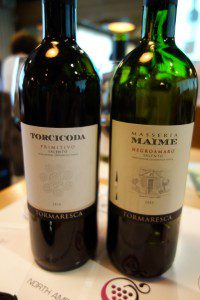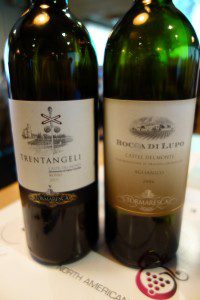13 Jun Italian Wine Focus: Wines of Puglia
Despite achieving an Italian Wine Specialist Certification from the North American Sommelier Association, one can never get too much information about the wines from Italy. With 20 regions and 3000 varietals, really mastering the wines of Italy is on on-going process. So, over the last few weeks, I jumped at the chance to attend four seminars hosted by The North American Sommelier Association, focusing on 4 regions of Italy.
Seminar 1: Wines of Puglia
Led by Alessia Botturi of the North American Sommelier Association and Vito Palumbo of Tormaresca.
Puglia, otherwise known as the “heel of Italy”, is between two seas – the Adriatic and the Eonan, both part of the Mediterranean. What was once known as the “cellar of Europe” because of the bulk wine production and sales of grapes to France, Tuscany and Veneto, it is now one of the centers for the best wines in Italy as quality has increased and quantity has decreased.
Puglia is 7400 square miles, the size of Los Angeles and Orange County combined. 94.6 thousand hectares are planted, second only to Sicilia (Veneto is third with 68 thousand hectares. 15% of vineyards are organic certified and red wine production makes up 53% of the production. As the production of table wine decreases, the production of DOC and IGT wines is increasing. Today 12% of the IGTs in Italy area from Puglia and 6% of Italy’s DOCs are from Puglia.
The 4 main areas of Puglia are Daunia, Murgia, Messapia and Salento. Puglia consists of mainly flat land which allows for the mechanization of wine production. The weather is hot during the day and winter is short.
SALENTO
Called the “heel of Italy,” the highest concentration of DOC wines from Salento. The soil in this area is clay, limestone and terre rosso (red soil due to the iron content). Salento is home to some unique varietals including Negromaro, Primitivo and Malvasia Nero.
MESSAPIA
Known as the “land between two seas,” Messapia is the home of an ancient population called the “Massapi.” Carsisms shaped the landscape and the area is famous for the Alberobello village with Trulli homes.
MURGIA
Murgia is sub-divided into higher and lower Murgia. This area, formed by carsisms, is poor for vegetation and is mainly planted with olive trees that date back 1000-2000 years old. There is some Aglianico produced.
DAUNIA
Daunia is the land of white wines, Montepulciano and Nero di Troia. It is mostly flat land between the mountain and the sea.
There are 4 DOCGs – Primitivo di Manduria Dolce Naturale, Castel del Monte Bombino Nero, Castel del Monte Nero di Troia Riserva and Castel del Monte Rosso Riserva – and 29 DOCs.
More important than the appellation are the grapes of Puglia.
Primitivo means “early ripener.” A deep purple color with notes of berries and spices, it is a full body wine. The grape likes clay and limestone soils and prefers the alberello training system (ancient goblet).
Negromaro comes from the words nigra (latin) and mavro (greek). It is a vigorous grape that produces high yields. This mid to late ripener produces wines of intense red fruits (plum, berries), spices and flowers.
Aglianico has wrongly been mistaken for having Greek origins (hellas = ellenico) but it is impossible to follow a trail connecting them. The name Aglianico first appeared in 1500 and the DNA is not related to any modern Greek grape. This early budding but very late ripener produces a wine high in tannins and acidity. It is commonly known as the “Barolo of the south.” The three areas of Aglianico are Aglianico del Vulture, Castel del Monte and Taurasi
Uvo di Troia produces a wine that is a deep ruby color and low in acidity.
The wines featured at the tasting were from Tormaresca, named for the ancient seaside towers of the region.
2011 Tormaresca Chardonnay, Puglia IGT (90% Chardonnay, 10% Fiano)
Pale yellow color, this wine is 100% stainless steel. It is fresh and crisp with notes of white flowers, herbs, orange peel and tropical notes from the Fiano.
2011 Roycello Fiano, Salento IGT (100% Fiano)
Named after the bird that passes through the estate (and the Fiano vines) each year, the wine is a pale yellow color with notes of orange blossom and tropical fruit. It is a fresh, crisp wine with structure.
2009 Torcicoda, Salento IGT (100% Primitivo)
Deep ruby red, this wine is big and jammy maintains its acidicty. There are hints of plum, blackberry, eucalyptus, licorice and cloves.
2005 Masseria Maime, Salento IGT (100% Negroamaro)
This big red has notes of cherry and raspberry as well as licorice and vanilla.
2009 Trentangeli, Rosso Castel del Monte DOC (65% Aglianico, 25% Cabernet Sauvignon, 10% Syrah)
Intense ruby red color, the wine has notes of ripe red fruit, cherry and spice. The tannins are smooth and the wine has great acidity.
2006 Bocca di Lupo, Castel del Monte DOC (100% Aglianico)
Meaning “mouth of the wolf,” Bocca di Luppo has a floral and perfumed nose, as well as dried fruits, spices and Mediterranean herbs.
Discover more from Please The Palate
Subscribe to get the latest posts sent to your email.







